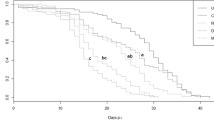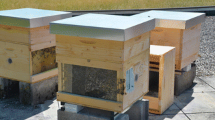Abstract
Social insect colonies are characterized by extensive interactions among individuals, exchanges that can also potentially transmit pathogens. The large majority of these social interactions in a honeybee colony result from food transfer among individuals. Since colony hunger is likely to have a significant influence on these interactions, we investigated its effect on the distribution of food within the colony. By pulsing two colonies having different amounts of stored food with a radioactive label, we found that a starved colony sent out a larger number of foragers, brought in more food, and stored more of it than the satiated colony. We also found that the food brought into a starved colony was distributed more uniformly within each age class than that in the satiated colony. The queen and the young individuals received the lowest exposure to the label even though the label entered different regions of the colony at the same rate. The satiation level of the colony did not influence the relative exposures of different age groups to the label but a higher amount of it was stored in the hungry colony. We discuss the significance of these results in terms of the role played by the organizational structure of the honeybee colony on the transmission dynamics of an infectious disease.




Similar content being viewed by others
References
Abramoff M.D., Magelhaes P.J. and Ram S.J. 2004. Image processing with ImageJ. Biophotonics Intl. 11: 36-42
Arathi H.S., Burns I. and Spivak M. 2000. Ethology of hygienic behaviour in the honey bee Apis mellifera L. (Hymenoptera: Apidae): Behavioural repertoire of hygienic bees. Ethology 106: 365-379
Bailey L. 1958. The epidemiology of the infestation of the honeybee, Apis mellifera L., by the mite Acarapis-woodi rennie and the mortality of infested bees. Parasitology 48: 493-506
Bailey L. 1960. The epizootiology of European foulbrood of the larval honey bee, Apis mellifera Linnaeus. J. Insect Pathol. 2: 67-83
Bailey L. and Gibbs A.J. 1964. Acute infection of bees with paralysis virus. J. Insect Pathol. 6: 395-407
Bailey L. 1981. Honey Bee Pathology. Academic Press, London. 193 pp
Durrer S. and Schmid-Hempel P. 1994. Shared use of flowers leads to horizontal pathogen transmission. Proc. R. Soc. Lond. B 258: 299-302
Fenoy S., Rueda C., Higes M., Martín-Hernández R. and Aguila C. 2009. High resistance of Nosema ceranae, a parasite of honeybee, to temperature and desiccation. Appl. Environ. Microbiol. 75: 6886-6889
Fewell J.H. and Winston M.L. 1996. Regulation of nectar collection in relation to honey storage levels by honey bees, Apis mellifera. Behav. Ecol. 7: 286-291
Higes M., Martín-Hernández R., Garcíá-Palencia P., Marín P. and Meana A. 2009. Horizontal transmission of Nosema ceranae (Microsporidia) from worker honeybees to queens (Apis mellifera). Environmental Microbiology Reports 1: 495-498
Howard D.F. and Tschinkel W.R. 1980. The effects of colony size and starvation on food flow in the fire ant, Solenopsis invicta (Hymenoptera: Formicidae). Behav. Ecol. Sociobiol. 7: 293-300
Mayack C. and Naug D. 2009. Energetic stress in the honeybee Apis mellifera from Nosema ceranae infection. J. Invert. Pathol. 100: 185-188
McMahan E.A. 1966. Food transmission within the Cryptotermes brevis colony (Isoptera: Kalotermitidae). Ann. Entomol. Soc. Am. 59: 1131-1137
Naug D. and Camazine S. 2002. The role of colony organization on pathogen transmission in social insects. J. Theor. Biol. 215: 427-439
Naug D. and Smith B.H. 2007. Experimentally induced change in infectious period affects transmission dynamics in a social group. Proc. R. Soc. Lond. B 274: 61-65
Naug D. 2008. Structure of the social network and its influence on transmission dynamics in a honeybee colony. Behav. Ecol. Sociobiol. 62: 1719-1725
Naug D. and Gibbs A. Behavioral changes mediated by hunger in honeybees infected with Nosema ceranae. Apidologie (in press)
Nixon H.L. and Ribbands C.R. 1952. Food transmissin within the honeybee community. Proc. R. Soc. Lond. B 140: 43-50
Schulz D.J., Huang Z.Y. and Robinson G.E. 1998. Effects of colony food shortage on behavioral development in honey bees. Behav. Ecol. Sociobiol. 42: 295-303
Schulz D.J., Vermiglio M.J., Huang Z.Y. and Robinson G.E. 2002. Effects of colony food shortage on social interactions in honey bee colonies. Insect. Soc. 49: 50-55
Seeley T.D. 1989. Social foraging in honey bees: how nectar foragers assess their colony’s nutritional status. Behav. Ecol. Sociobiol. 24: 181-199
Spragg W.T. and Fox R.E. 1974. The use of radioactive tracer to study the nesting system of Mastotermes darwinensis Frogat. Insect. Soc. 21: 18-25
Suarez M.E. and Thorne B.L. 2000. Rate, amount and distribution pattern of alimentary fluid transfer via trophallaxis in three species of termites (Isoptera, Rhinotermitidae, Termopsidae). Annls Entomol. Soc. Am. 93: 145-155
Toth A.L., Kantarovich S., Meisel A.F. and Robinson G.E. 2005. Nutritional status influences socially regulated foraging ontogeny in honey bees. J. Exp. Biol. 208: 4641-4649
Visscher K. 1980. Adaptions of honey bees (Apis mellifera) to problems of nest hygiene. Sociobiology 5: 249-260
Waddington K.D. and Rothenbuhler W.C. 1976. Behaviour associated with hairless-black syndrome of adult honeybees. J. Apicult. Res. 15: 35-41
Wallis D.I. 1962. The relation between hunger, activity and worker function in an ant colony. Proc. Zool. Soc. Lond. 139: 589-605
Wilson E.O. and Eisner T. 1957. Quantitative studies of liquid food transmission in ants. Insect. Soc. 4: 157-166
Woodrow A.W. and Holst E.C. 1942. The mechanism of colony resistance to American foulbrood. J. Econ. Entomol. 35: 327-330
Acknowledgments
We would like to thank Salah Abdel-Ghany, Chris Cohu and Marinus Pilon for lending us their radioactive-isotope expertise and facilities. This study was supported by a NSF grant to D.N., who designed the experiment and wrote the paper with C.F. who collected and analyzed the data.
Author information
Authors and Affiliations
Corresponding author
Rights and permissions
About this article
Cite this article
Feigenbaum, C., Naug, D. The influence of social hunger on food distribution and its implications for disease transmission in a honeybee colony. Insect. Soc. 57, 217–222 (2010). https://doi.org/10.1007/s00040-010-0073-6
Received:
Revised:
Accepted:
Published:
Issue Date:
DOI: https://doi.org/10.1007/s00040-010-0073-6




